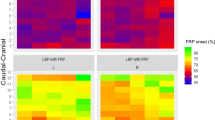Abstract
Within recent years clinicians and researchers have applied paraspinal EMG biofeedback procedures during static and dynamic movement retraining of chronic low back pain patients. Most of these applications make use of surface electromyography, an approach complicated by the fact that the erector spinae muscles are deeply situated. This descriptive study reveals that extraneous movements, such as neck flexion and pelvic rotation, can elicit profound activity from percutaneously placed EMG electrodes while little change is seen at the skin surface. The implications of these observations for the use of EMG feedback to remediate low back pain are discussed.
Similar content being viewed by others
References
Ahern, D. K., Follick, M. J., Council, J. R., & Laser-Wolston, M. A. (1986). Reliability of lumbar para-vertebral EMG assessment in chronic low back pain.Archives of Physical Medicine and Rehabilitation, 67 762–765.
Basmajian, J. V. (1976). A fresh look at the intrinsic muscles of the back.American Surgery, 42 685–690.
Basmajian, J. V., & DeLuca, C. J. (1985).Muscles alive: Their function revealed by electromyography (5th ed., pp. 354–366). Baltimore: Williams and Wilkins.
Basmajian, J. V., & Stecko, G. (1962). A new bipolar electrode for electromyography.Journal of Applied Physiology, 17 849.
Belar, C. D., & Cohen, J. L. (1979). The use of EMG feedback and progressive relaxation in the treatment of a woman with chronic back pain.Biofeedback and Self-Regulation, 4 345–353.
Cram, J. R., & Engstrom, D. (1986). Pattern of neuromuscular activity in pain and non-pain patients.Clinical Biofeedback and Health, 9 55–61.
Cram, J. R., & Steger, J. S. (1983). EMG scanning in the diagnosis of chronic pain.Biofeedback and Self-Regulation, 8 229–242.
Flor, H., Haag, G., Turk, D. C., & Koehler, H. (1983). Efficacy of EMG biofeeback, pseudotherapy, and conventional medical treatment for chronic rheumatic back pain.Pain, 17 21–31.
Freeman, C. W., Calsyn, D. A., Paige, A. B., & Halar, E. M. (1980). Biofeedback with low back pain patients.American Journal of Clinical Biofeedback, 3 118–122.
Gentry, W. D., & Bernal, G. A. A. (1977). Chronic pain. In R. B. Williams & W. D. Gentry (Eds.),Behavioral approaches to medical treatment (pp. 173–182). Cambridge, MA: Ballinger.
Hoyt, W. H., Hunt, H. H., Jr., DePauw, M. A., Bard, D., Shaffer, F., Passias, J. N., Robbins, D. H., Jr., Runyon, D. G., Semrad, S. E., Symonds, J. T., & Watt, K. C. (1981). Electromyographic assessment of chronic low-back pain.Journal of the American Osteopathic Association, 80 728–730.
Jonsson, B. (1970). The functions of individual muscles in the lumbar part of the spinate muscle.Electromyography, 1 5–21.
Keefe, F. J., Block, A. R., Williams, R. B., & Surwit, R. S. (1981). Behavioral treatment of chronic low back pain: Clinical outcome and individual differences in pain relief.Pain, 11 221–231.
Keefe, F. J., & Hoelscher, T. J. (1987). Biofeedback in the management of chronic pain syndromes. In J. P. Hatch, J. G. Fisher, & J. D. Rugh (Eds.),Biofeedback: Studies in clinical efficacy (pp. 211–253). New York: Plenum Press.
Kravitz, E., Moore, M. E., & Glaros, A. (1981). Paralumbar muscle activity in chronic low back pain.Archives of Physical Medicine and Rehabilitation, 62 172–176.
Nouwen, A. (1983). EMG biofeedback used to reduce standing levels of paraspinal muscle tension of chronic low back pain.Pain, 17 353–360.
Nouwen, A., & Bush, C. (1984). The relationship between paraspinal EMG and chronic low back pain.Pain, 20 109–123.
Nouwen, A., Van Akkerveeken, P. F., & Versloot, J. M. (1987). Patterns of muscular activity during movement in patients with chronic low back pain.Spine, 12 777–782.
Schultz, A. B., Haderspeck-Grib, K., Sinkora, G., Warwick, D. N. (1985). Quantitative studies of the flexion-relaxation phenomenon in the back muscles.Journal of Orthopaedic Research, 3 189–197.
Seres, J. L., & Newman, R. I. (1976). Results of treatment of chronic low back pain at the Portland Pain Center.Journal of Neurosurgery, 45 32–36.
Wolf, L. B., Segal, R. L., Wolf, S. L., & Nyberg, R. (1988). A quatitative analysis of integrated surface and percutaneous EMG activity in lumbar erector spinae of normal young women.Spine.
Wolf, S. L., Basmajian, J. V., Russe, C. T. C., & Kutner, M. (1979). Normative data on low back mobility and activity levels: Implications for neuromuscular reeducation.American Journal of Physical Medicine, 58 217–229.
Wolf, S. L., Nacht, M., & Kelly, J. L. (1982). EMG feedback training during dynamic movement for low back pain patients.Behavior Therapy, 13 395–406.
Author information
Authors and Affiliations
Additional information
This work was supported in part by Grant No. G008300041 from the National Institute on Disability and Rehabilitation Research, Department of Education, Washington, D.C.
Rights and permissions
About this article
Cite this article
Wolf, S.L., Wolf, L.B. & Segal, R.L. The relationship of extraneous movements to lumbar paraspinal muscle activity: Implications for EMG biofeedback training applications to low back pain patients. Biofeedback and Self-Regulation 14, 63–74 (1989). https://doi.org/10.1007/BF00999341
Issue Date:
DOI: https://doi.org/10.1007/BF00999341




